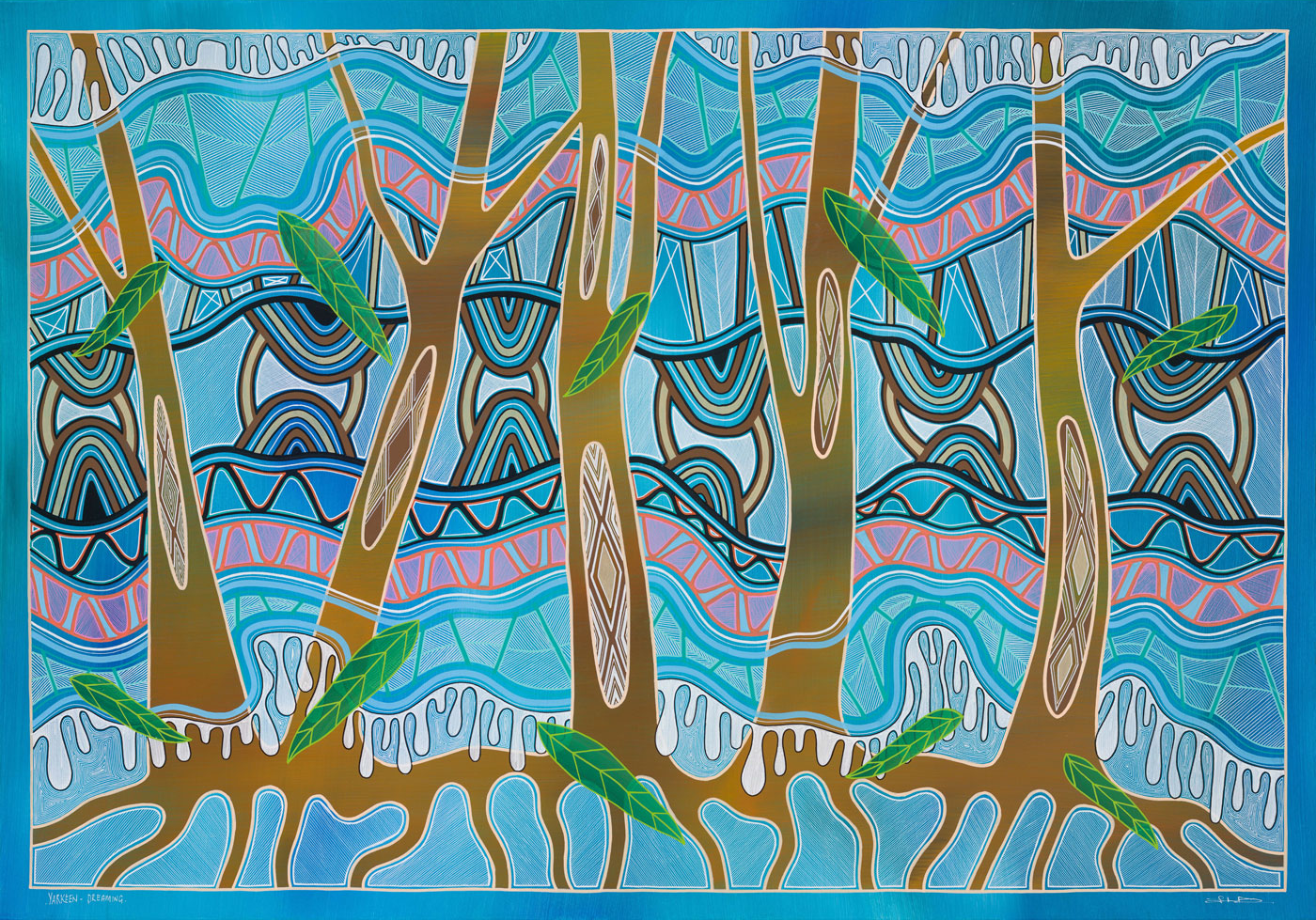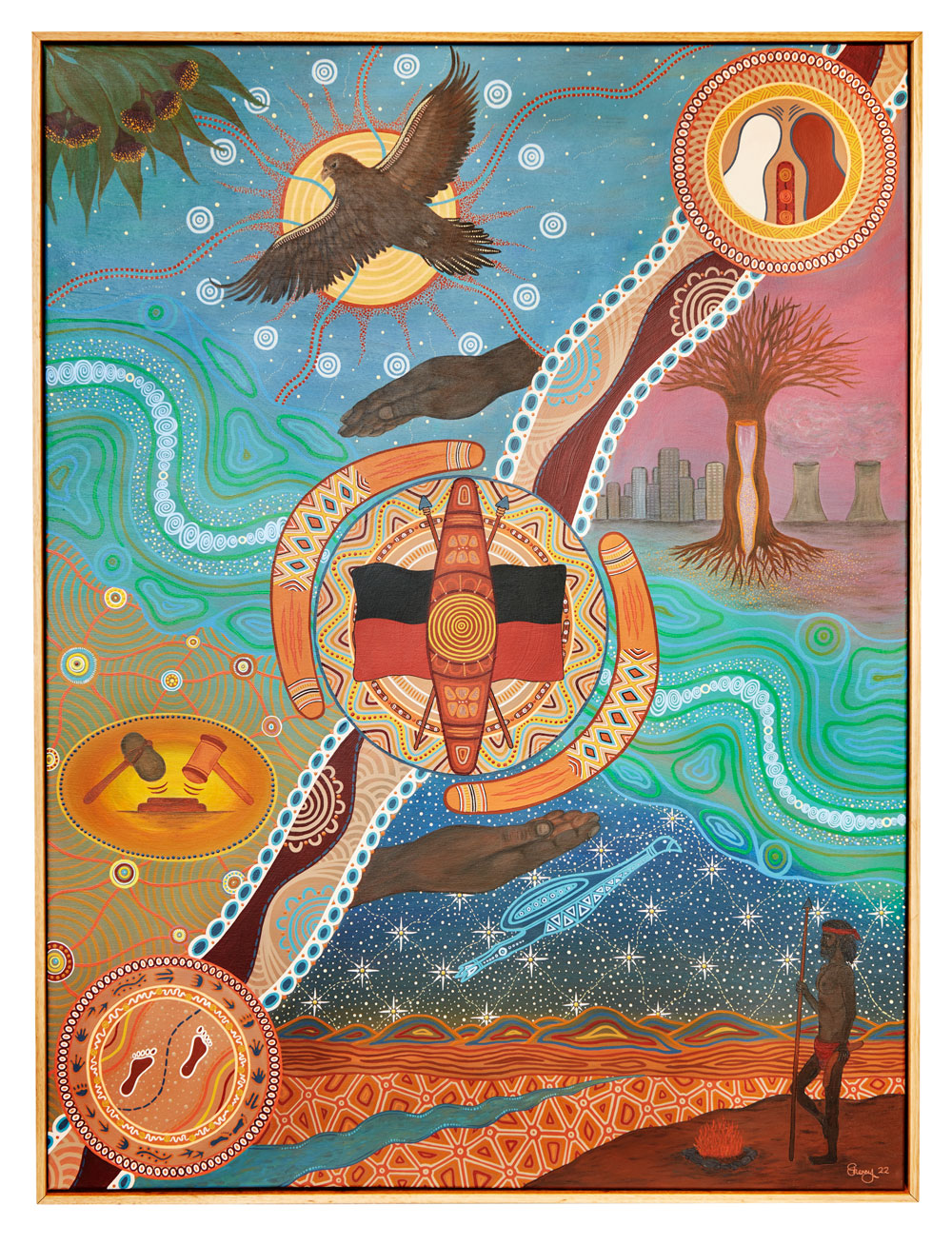Our Artwork
The stories behind the Assembly’s artwork
The Assembly logo is part of a bigger piece of art called ‘Yarkeen’, by Tom Day

“The artwork reflects the First Peoples’ Assembly of Victoria.
The predominant image is the trees, strong and powerful roots planted deep within country. The scars representing culture and identity, formed from generations passing on knowledge, ensuring a continuing succession of proud and strong Peoples.
The leaves signify the future, the generations that will continue to come, benefiting by the seeds planted by the previous generations and the present.
The central design represents the coming together of the Assembly. The diversity of countrymen and countrywomen, young and old, linked by purpose.
The designs above and below the central design represent the journey being embarked on. The above design representing the conversation to date and the below design representing the conversation to come, unwritten, a new chapter.
The pink and orange design represents the past, our old people, our elders, our leaders, now in the dreaming but ever present. The reason we exist today is in their strength, courage, wisdom and compassion. Traits of character integral as much today as it was in the past.
The designs above and below the pink and orange design represent our lineages, from across the state. Each with a powerful story, each powerful and proud, evident today as it ever was.
The individual lines throughout the piece are representative of the people, past, present and the future.
The artwork is titled Yarkeen, a Gunditjmara word for dreaming, for we all dream of a better future for our generations that are coming and there is a power in a collective dream.”
Tom Day
Gunditjmara, Yorta Yorta, Wemba Wemba
‘Drivers of our own Destiny’ by Sherry Johnstone, Spirit and Soul Creations
To embed First Peoples’ culture in the Treaty Negotiation Framework, we asked Sherry Johnstone to create an artwork that represents the Treaty Process for First Peoples in Victoria.

Artwork Story
Bottom left circle: Is about remembering who roamed this land firstour ancestors who planted the seeds of culture, tradition and connection, living in harmony with the land and animals.
Along the bottom: We are the original custodians of the lands. We belong to it; we are part of it. We have been responsible for it for thousands of years and are obligated to protecting its future. We are all now obligated to looking after its longevity and with our ancient knowledge and wisdom we can teach you.
The pattern in the land at the bottom: represents our connection to the land, waterways, our songlines, people and places.
The stars: The stars hold our dreaming, its where our ancestors are, our people were the first astronomers. We were able to use them for navigation, indications of seasonal change and animal breeding behaviours.
The dark emu: represents our creation and dreaming stories. The middle circle: The shield represents protection of our ancestor’s plight, protection of culture, story, practice, and traditions. The flag represents first nations people, their aboriginality and their identity. Within the circle is message sticks, representing continuing to pass on our culture, wisdom, knowledge and stories. The spears behind the flag represents our lore. The wavy lines in the outer circle represent the energy and effort we have had to continue to put out in order to have our voices heard.
The boomerangs: Represent our values and practices always coming back to our ancestors way and bringing back our ways for our people. Within the boomerangs are windows of opportunities that will open-up to our people when a Treaty agreement is reached. The scars in the boomerangs represent the scars and wounds we still carry from our ancestors sacrifices, fighting for their land, recognition and to have their voices heard and culture valued.
The hands: The hands represent our future will be back in our own hands. Through Treaty will be drivers of our own destiny. They also represent our ancestors supporting and guiding us along the way.
The waterways coming out from each side of the middle circle: Our waterways are the veins of Mother Earth and are a vital part of our existence and eco system. Water is life. We need to protect and nurture them.
The tree with the hourglass inside: represents us running out of time to repair the damage that’s been done to Country, waterways and the ocean. From carbon emissions, our ever -increasing population and development, natural and man-made disasters, bush fire management, deforestation, pollution and climate change. By engaging First Nations people’s ancient knowledge and wisdom we can make a difference to these issues.
The top right-hand circle: represents First Nations people and the Government coming together to reach an agreement. With the message stick in the middle showing the meetings and gatherings to achieve this. The patterns around this represent working together, entwining our energies like a woven basket to become stronger together. The small seeds around the outside of the circle represent again, planting the seeds for our future generation’s wellbeing and cultural safety.
Bunjil the Eagle: Bunjil represents once an agreement is made, how like a bird it will free our spirits, allowing us to spread our wings and take flight, reaching great heights, fulfilling our potential and finding our cultural purpose.
The Sun: The sun behind Bunjil represents, with a Treaty, First Nations people’s futures are much brighter. The leaves: The leaves represent – like the healing power of nature and bush medicine, Treaty will begin a healing process for Aboriginal people and like the native wildflowers we will blossom and grow.
The Journey line running from the bottom left circle, through the middle circle and up to the top right circle: represents honouring our ancestors plight and journey. On the outside are the stepping stones as we take one step at a time on the journey towards Treaty.
About the Artist
Sherry Johnstone is a proud Keerray Woorroong (Gunditjmara)/ Yorta Yorta woman and artist living in Warrnambool. Through her interest in art she completed a signwriting apprenticeship after finishing school, then went onto working with the local Aboriginal community for the past 27 years, providing cultural and educational support to Aboriginal children as a Koorie Educator, a Koorie Playgroup facilitator, and as a Koorie Pre-School Assistant.
She then worked with the Department of Health and Human Services to create Cultural Plans for the Koori children in out of home care in the South – West Region and then went onto working with Aboriginal women effected by Family Violence. In 2019 Sherry became the first, First Nations Curator of Cultural Engagement at the Warrnambool Art Gallery for two years before recently resigning to become a full time Contemporary Aboriginal Artist running her own business called Spirit and Soul Creations. Sherry’s art blends traditional knowledge and symbolism with the new.
Infusing cultural connection, story and perspective in a contemporary style. She is passionate about sharing her culture to help create a greater understanding and awareness, building respectful relationships, moving forward towards a better future working together.